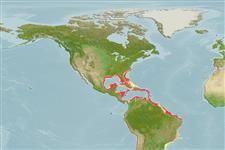Common names from other countries
Environment: milieu / climate zone / depth range / distribution range
Ecologia
marinhas demersal; intervalo de profundidade 8 - 73 m (Ref. 93147). Tropical
Western Atlantic: eastern Gulf of Mexico, southern Florida in USA to northern South America.
Tamanho / Peso / Idade
Maturity: Lm ? range ? - ? cm
Max length : 10.0 cm TL macho/indeterminado; (Ref. 7251)
Espinhos dorsais (total) : 7; Raios dorsais (total) : 12 - 13; Espinhos anais: 1; Raios anais : 11 - 13. Distinguished by the following characteristics: eye diameter 7.7-10% SL; typically, D I,12 and A I,12; D1 spines not distinctly elongate; first and D2 fins with 3-5 brown or tan horizontal stripes; upper lip lightly pigmented to pale, absence of a dark stripe above upper lip; pelvic disk lightly pigmented to pale; 4-5 dark brown blotches along lateral midline of the body; blotches often connected by slightly lighter horizontal band of pigment along lateral midline; longitudinal papillae row b originating at vertical through anterior margin of pupil (Ref. 93147); laterally compressed head and body; large mouth and very oblique; completely scaled body with ctenoid scales; first dorsal with VII spines; pelvic fins fused forming a disc; caudal fin lanceolate (Ref. 92840).
Inhabits offshore waters (Ref. 7251), over mud or sand-mud bottoms (Ref. 13628); flat areas with fine sediment near coral reefs (Ref. 93147).
Ciclo de vida ou comportamento de acasalamento
Maturities | Reprodução | Spawnings | Egg(s) | Fecundities | Larvas
Van Tassell, J.L., L. Tornabene and P.L. Colin, 2012. Review of the western Atlantic species of Bollmannia (Teleostei: Gobiidae: Gobiosomatini) with the description of a new allied genus and species. aqua, Int. J. Ichthyol. 18(2):61-94. (Ref. 93147)
Status na Lista Vermelha da UICN (Ref. 130435)
CITES (Ref. 128078)
Not Evaluated
Ameaça para os humanos
Harmless
Uso pelos humanos
Pescarias: espécies comerciais; Aquário: Espécies comerciais
Ferramentas
Relatórios especiais
Baixar XML
Fontes da internet
Estimates based on models
Preferred temperature (Ref.
115969): 24.5 - 28, mean 27 (based on 226 cells).
Índice de diversidade filogenética (Ref.
82804): PD
50 = 0.5005 [Uniqueness, from 0.5 = low to 2.0 = high].
Bayesian length-weight: a=0.00708 (0.00333 - 0.01504), b=3.09 (2.92 - 3.26), in cm Total Length, based on LWR estimates for this (Sub)family-body shape (Ref.
93245).
Nível Trófico (Ref.
69278): 3.3 ±0.4 se; based on size and trophs of closest relatives
Resiliência (Ref.
120179): Elevada, tempo mínimo de duplicação da população menor que 15 meses (Preliminary K or Fecundity.).
Fishing Vulnerability (Ref.
59153): Low vulnerability (10 of 100).
